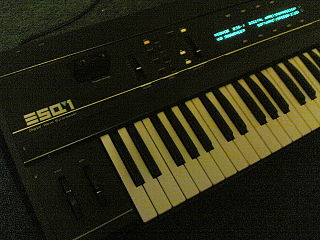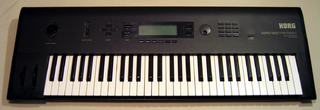
A digital synthesizer is a synthesizer that uses digital signal processing (DSP) techniques to make musical sounds. This in contrast to older analog synthesizers, which produce music using analog electronics, and samplers, which play back digital recordings of acoustic, electric, or electronic instruments. Some digital synthesizers emulate analog synthesizers; others include sampling capability in addition to digital synthesis.

An electronic musical instrument or electrophone is a musical instrument that produces sound using electronic circuitry. Such an instrument sounds by outputting an electrical, electronic or digital audio signal that ultimately is plugged into a power amplifier which drives a loudspeaker, creating the sound heard by the performer and listener.
A software synthesizer or softsynth is a computer program that generates digital audio, usually for music. Computer software that can create sounds or music is not new, but advances in processing speed now allow softsynths to accomplish the same tasks that previously required the dedicated hardware of a conventional synthesizer. Softsynths may be readily interfaced with other music software such as music sequencers typically in the context of a digital audio workstation. Softsynths are usually less expensive and can be more portable than dedicated hardware.

Modular synthesizers are synthesizers composed of separate modules for different functions. The modules can be connected together by the user to create a patch. The outputs from the modules may include audio signals, analog control voltages, or digital signals for logic or timing conditions. Typical modules are voltage-controlled oscillators, voltage-controlled filters, voltage-controlled amplifiers and envelope generators.

A groovebox is a self-contained electronic or digital musical instrument for the production of live, loop-based electronic music with a high degree of user control facilitating improvisation. The term "Groovebox" was originally used by Roland Corporation to refer to its MC-303, released in 1996. The term has since entered general use, and dates back to the Movement Computer Systems Drum Computer in 1981.

Oberheim Electronics is an American manufacturer of audio synthesizers and a variety of other electronic musical instruments. Founded in 1969 by Tom Oberheim.

Ensoniq ESQ-1 is a 61-key, velocity sensitive, eight-note polyphonic and multitimbral synthesizer released by Ensoniq in 1985. It was marketed as a "digital wave synthesizer" but was an early Music Workstation. Although its voice generation is typically subtractive in much the same fashion as most analog synthesizers that preceded it, its oscillators are neither voltage nor "digitally controlled", but true digital oscillators, provided by a custom Ensoniq wavetable chip. The signal path includes analog resonant low-pass filters and an analog amplifier.

The Jupiter-8, or JP-8, is an eight-voice polyphonic analog subtractive synthesizer introduced by Roland Corporation in early 1981.

The Roland MC-202 (MicroComposer) is a monophonic analog synthesizer and music sequencer released by Roland in 1983. It was the first groovebox. Its synth is similar to the TB-303 bass synth and the SH-101 synthesizer, featuring one voltage-controlled oscillator with simultaneous saw and square/pulse-width waveforms. It is a successor to the Microcomposer family of sequencers, including the MC-8 and MC-4. The unit is portable and can be operated from batteries or an external power supply.

The Moog synthesizer is a modular synthesizer developed by the American engineer Robert Moog. Moog debuted it in 1964, and Moog's company R. A. Moog Co. produced numerous models from 1965 to 1981, and again from 2014. It was the first commercial synthesizer, and is credited with creating the analog synthesizer as it is known today.
An analog modeling synthesizer is a synthesizer that generates the sounds of traditional analog synthesizers using DSP components and software algorithms. Analog modeling synthesizers simulate the behavior of the original electric and electronic circuitry in order to digitally replicate their tone.

The microKORG is a MIDI-capable digital synthesizer/vocoder from Korg featuring DSP analog modelling. The synthesizer is built in such a way that it is essentially a Korg MS-2000 with programmable step arpeggiator, a less advanced vocoder, lack of motion sequencing, lack of an XLR microphone input, and in a smaller case with fewer real-time control knobs.
Polyphony is a property of musical instruments that means that they can play multiple independent melody lines simultaneously. Instruments featuring polyphony are said to be polyphonic. Instruments that are not capable of polyphony are monophonic or paraphonic.

The Korg Wavestation is a vector synthesis synthesizer first produced in the early 1990s and later re-released as a software synthesizer in 2004. Its primary innovation was Wave Sequencing, a method of multi-timbral sound generation in which different PCM waveform data are played successively, resulting in continuously evolving sounds. The Wavestation's "Advanced Vector Synthesis" sound architecture resembled early vector synths such as the Sequential Circuits Prophet VS.

The Roland XP-80 is a music workstation that uses digital PCM subtractive synthesis and combines an updated version of the JV-1080 synthesizer engine with the sequencer capabilities of the Roland MRC-Pro sequencer. The XP-80 was introduced in 1996 and is now discontinued.

Quasimidi Musikelektronik GmbH was a German synthesizer manufacturer from Hesse. It was founded in 1987 by Friedhelm Haar and Jörg Reichstein. It was originally based in Kirchhain, but moved to Rauschenberg in 1998. The company folded in 2000.
The Yamaha FS1R is a sound synthesizer module, manufactured by the Yamaha Corporation from 1998 to 2000. Based on Formant synthesis, it also has FM synthesis capabilities similar to the DX range. Its editing involves 2,000+ parameters in any one 'performance', prompting the creation of a number of third party freeware programming applications. These applications provide the tools needed to program the synth which were missing when it was in production by Yamaha. The synth was discontinued after two years, probably in part due to its complexity, poor front-panel controls, brief manual and limited polyphony.

A synthesizer is an electronic musical instrument that generates audio signals. Synthesizers typically create sounds by generating waveforms, through methods including subtractive synthesis, additive synthesis and frequency modulation synthesis. These sounds may be altered by components such as filters, which cut or boost frequencies; envelopes, which control articulation, or how notes begin and end; and low-frequency oscillators, which modulate parameters such as pitch, volume, or filter characteristics affecting timbre. Synthesizers are typically played with keyboards or controlled by sequencers, software or other instruments, and may be synchronized to other equipment via MIDI.

The Sirius is a keyboard "groove-synth," featuring a subtractive hybrid-tone-generation synthesizer referred to as DTE synthesis introduced in 1997 by Quasimidi. The unit featured both real-time and step sequencers with pattern- and song-modes, capable of acting basic drum machine, groove-box, or sound-module.
The Quasimidi Rave-O-Lution 309 is a stand-alone groovebox produced by Quasimidi in 1996. It features an onboard sequencer and has the ability to mute parts during playback making this unit ideal for live performances. The machine features two oscillators for sound generation,















